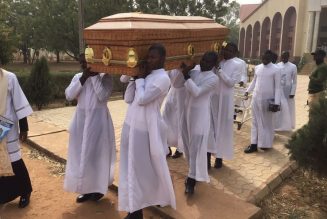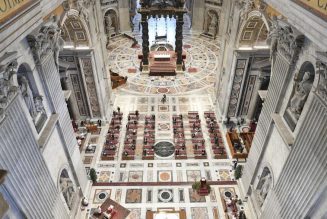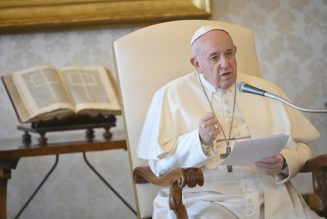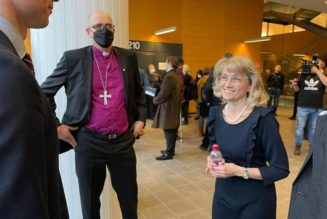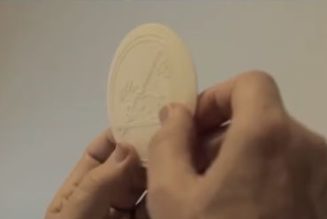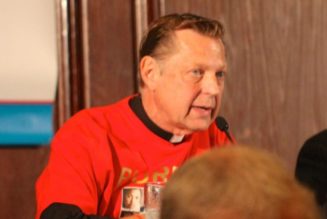
As a young man, Darren Balkey knew he was called to a life of service. He just wasn’t sure if it was to the priesthood or to military service in the U.S. armed forces.
If his current trajectory is any indication, it seems the answer is “both.”
Ordained a transitional deacon for the Diocese of Charlotte, North Carolina, this past summer, Balkey is also a staff officer in the U.S. Navy, having been commissioned in fall 2020. Both were necessary steps on the journey toward serving as an active-duty military chaplain, a unique ministry that brings together Balkey’s attractions to both the priesthood and the military.
“I couldn’t think of one without the other,” shared Balkey, 28, who says military chaplaincy and priestly ordination have always “traveled” together in his discernment.
Needed Reinforcements
Deacon Balkey is in his final year of seminary at Mount St. Mary’s Seminary and School of Theology in Cincinnati, a formation that has been jointly sponsored by his home diocese and the Archdiocese for the Military Services, USA (AMS). After being ordained a priest, he’ll serve diocesan assignments for three years back in North Carolina while also completing preparations for chaplaincy. Then, if all goes to plan, he’ll begin a five-year stretch of active-duty service in 2025.
Archbishop Timothy Broglio and the Military Services Archdiocese will be happy to have him. Over the past 20 years, the number of active-duty priest chaplains has been halved, from more than 400 to only 188 today. These priest chaplains are spread across three branches of the military and are responsible for the pastoral care of the roughly 300,000 active-duty Catholic service members and their families.
That means, in the military, there’s one priest for every 1,600 Catholics. The figure is comparable to the overall rate of priests per Catholic in the U.S., but there’s an important distinction: The limited number of active-duty priests means service members deployed overseas may have extremely limited access to the sacraments and other important aspects of an observant Catholic life. For instance, during the Iraq War, one priest chaplain was responsible for a region roughly the size of Pennsylvania.
Similarly, the Catholic presence is muted even on domestic military installations, something Archbishop Broglio expressed concern over in a recent article in Salute, the Military Services Archdiocese’s magazine. While Catholics make up 20% of the military, only 8% of military chaplains are Catholic priests. The archbishop suggested that the disparity gives rise to a distinctively Protestant form of ministry in the armed forces, even noting that service members raised Catholic sometimes end up leaving the faith because of the lack of a vital Catholic presence. He even floated the idea that bishops may soon have to discourage Catholics from serving in the military if it means impairing their spiritual life.
As a partial solution, Archbishop Broglio has pushed strongly for an expansion of “priest “contractors,” or civilian priests hired by the military, to offer religious services on base. But his preference would probably be to have more priest chaplains, who are commissioned officers in the military.
In one sense, the shortage of military chaplains is ironic, given that the military is fruitful soil for priestly vocations. According to AMS literature, almost 10% of new priests in the U.S. have previous military experience, and around 20% came from military families.
Deacon Balkey has experienced the shortage of priest chaplains firsthand. When visiting military installments as part of his preparation for chaplaincy, he says it’s not uncommon for him to be referred to as a “unicorn” by chaplains of other religious traditions, “just because it’s so rare to find a priest chaplain,” or at least a man preparing to become one.
“You’re really sought after, because they know that priests are a powerful presence,” noted the transitional deacon and Navy officer.
A Call Within a Call
In the face of such dire need, what draws a man to pursue military chaplaincy — a “call within a call” — on top of typical priestly ministry?
Balkey says he was long attracted to a military career; in fact, he applied for the Coast Guard out of high school. In part, the uniformed aspect of military service appealed to him, the idea that one wore identity and commitments “on their sleeve.”
At the same time, there was also a sense that military service “didn’t hit all the answers” — that, as important as the service of country was, something transcendent was missing, something Balkey says he has found in the ministerial service of the Church.
An AMS-sponsored retreat event before he entered seminary helped him to see that chaplaincy was a possibility, and Deacon Balkey says he also benefited from the guidance of Father Louis Isaiello, who served as the chief of chaplains of the U.S. Navy, later teaching at the Pontifical College Josephinum in Columbus, Ohio, where Balkey completed his pre-theology studies.
For Father Madison Hayes, the call to priesthood and chaplaincy have been even more deeply connected. In fact, his life’s experience of Catholicism is intimately connected with military service. The 33-year-old priest, ordained for the Archdiocese of Anchorage, Alaska, this past August, grew up in a military family stationed overseas. His family entered the Catholic Church through the RCIA program offered in the installation chapel on Ramstein Airbase in Germany.
“My ‘parish’ growing up was a military chapel, and my pastor was always a military priest chaplain,” said Father Hayes, who is an officer in the Air Force.
Hayes enlisted in the military after college and began to discern a possible priestly vocation more seriously. He met with a military chaplain for spiritual direction and says his reengagement with the military chapel community in which he grew up “reignited my call to serve that community as a priest chaplain.” Pursuing priesthood and chaplaincy have “always ran parallel with each other” for Father Hayes.
But other men preparing to serve as active-duty chaplains don’t have any military background. Father Eugene Savarimuthu, for instance, is in the process of becoming a chaplain after 25 years of priesthood. The 51-year-old priest was ordained for the Diocese of Kumbakonam in India in 1997, before coming to the Diocese of Trenton, New Jersey, in 2004.
While serving at a parish in Tuckerton, New Jersey, Father Savarimuthu volunteered as the religious support for 177 Air National Guard for seven years. Additionally, Father Savarimuthu says he has a deep love for America’s founding and the country’s emphasis on the equal dignity of all persons, something he did not experience as an “untouchable” in India’s caste system.
These experiences helped the New Jersey priest pursue chaplaincy. After three years as a member of New Jersey’s National Guard, he’s preparing the needed paperwork and following the necessary processes to obtain the conditional release from his diocese needed to enter into active duty.
“I would like to achieve my full ability, by the grace of God, to serve those who serve our country,” he said.
Recruitment and Formation
Priest military chaplains are the stuff of legacy and lore, perhaps best exemplified these days by Father Emil Kapaun, the U.S. Army chaplain whose cause for canonization is underway.
However, the Archdiocese for the Military Services goes to great lengths to make sure potential candidates know that picking up the heroic mantle of chaplaincy is still possible today.
AMS holds two discernment retreats annually for young men considering both the priesthood and chaplaincy, most recently at Mount St. Mary’s in Cincinnati Oct. 21-24. An archdiocesan spokesman said “the most serious of these candidates” are then invited to an annual “Step Closer” retreat. AMS also provides an annual “For God and Country Discernment Retreat” for already-ordained priests who might be considering chaplaincy. Additionally, each branch of the military has a chaplain recruiter; these recruiters often visit places like Catholic seminaries to speak with interested candidates.
Archbishop Broglio has made chaplain recruitment one of his top priorities since becoming ordinary of the Military Services Archdiocese in 2007. And, in 2017, he made an appeal to his brother bishops at the bishops’ assembly to encourage their own priests and seminarians to consider becoming active-duty chaplains.
Some of these efforts seem to be bearing fruit. The Archdiocese for the Military Services currently co-sponsors 39 seminarians, men who at some point after their ordination will serve as active-duty chaplains. Archbishop Broglio has previously called the number of new recruits to military chaplaincy “a tremendous sign for the future.”
The archdiocese also provides ongoing formation for men whom it co-sponsors, including an annual meeting of all seminarian chaplain candidates in Washington, D.C., around Labor Day. Deacon Balkey says these gatherings have been some of the high points of his formation.
“I feel the most understood and at ease when I’m with my brother deacons who are also naval officers,” he shared.
Of course, preparation for chaplaincy also includes a significant amount of military work, which a candidate must fit into his busy schedule as a seminarian and then a diocesan priest. This includes a modified bootcamp for staff officers and a weeks-long chaplain candidate course, as well as pastoral assignments at military installations that usually take place in the summer. Three years of “civilian ministry” are also required by AMS before it will officially endorse a candidate for chaplaincy.
Father Hayes said the dual-formation can be “difficult to balance,” while Deacon Balkey joked that it was like he has four “chains of command”: his home diocese, his seminary, AMS, as well as his military branch. At the same time, Father Hayes notes the importance of additional assignments in helping a candidate develop the unique skills needed to be a chaplain, skills that a seminarian doesn’t necessarily pick up during typical diocesan formation.
Additionally, Father Hayes says that familiarizing himself with the particular struggles that Catholic service members face helped him focus on specific aspects of moral theology while he was in formation, “knowing that I was really going to be able to guide people on the other side of seminary.”
A Noble Mission
Father Hayes is on that other side now. He served as a priest this past summer at Grand Forks Air Force Base in North Dakota, an experience that he described as going to his “home parish.” Now back in the Archdiocese of Anchorage, he’s also waiting on an assignment in the reserves, which he’ll fulfill until he’s called to active duty in 2024.
Through his own experience of serving in the Air Force prior to seminary, Father Hayes knows that the military can be a “dangerous” environment for souls, “as they navigate the harsh realities of military service, war and politics,” he said. He says he finds the unique mission of a military chaplain — being integrated into the armed services, but at the same time somewhat “outside” of its limits — is “an opportunity to be a sign of transcendence” to those serving.
“The tension between the two was something that challenged me personally [when I served], and I feel called to lead people to God through these circumstances that our world finds itself in,” said Father Hayes.
One dimension of that mission Deacon Balkey looks forward to is walking with people wherever they’re at. Although priest chaplains have a special commitment to Catholics in the armed forces, they may be called upon to minister to anyone. Another wrinkle in their service — because they’re technically employees of the state — they’re not allowed to “proselytize” while on duty.
But Deacon Balkey says that can be good for a priest because “it takes a lot of your pride out of it.”
“Your evangelization really has to be a holy life,” he said. “If you’re pursuing your spiritual life and doing what you need to do, those conversations are just going to walk up to you.”
Father Hayes encourages other priests to consider serving in the military — “one of the most important elements of American society, which affects the entire world.” He notes that chaplains not only provide spiritual care to service members, but also advise military leadership on moral issues.
“I do not want to imagine a U.S. military that is totally detached from what only a priest can offer, especially in the Eucharist,” he said. “The deeds and words of Jesus need to be brought to every part of human society, but the military especially, because there is such a danger for souls in this service.”
Join Our Telegram Group : Salvation & Prosperity

